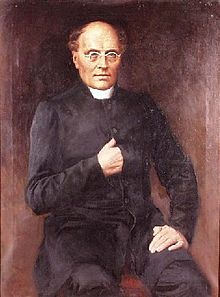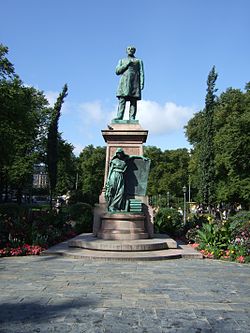Johan Ludvig Runeberg (Finland Swedish: [ˈjuːhɑn ˈlʉdːviɡ ˈrʉːnebærj]; 5 February 1804 – 6 May 1877)[1] was a Finnish priest, lyric and epic poet. He wrote exclusively in Swedish. He is considered a national poet of Finland. He is the author of the lyrics to Vårt land (Our Land, Maamme in Finnish) which became the Finnish national anthem. Runeberg was also involved in the modernization of the Finnish Lutheran hymnal and produced many texts for the new edition.[2][3]
Johan Ludvig Runeberg | |
|---|---|
 Portrait by Albert Edelfelt (1893) | |
| Born | 5 February 1804 Jakobstad, Swedish Empire |
| Died | 6 May 1877 (aged 73) Porvoo, Grand Duchy of Finland, Russian Empire |
| Spouse | Fredrika Tengström |
| Children | 8, including Walter |
| Signature | |

Background
editChildhood
editRuneberg was born into a Swedish-speaking family in Jakobstad, Finland, on the shores of the Gulf of Bothnia. His parents were sea captain Lorentz Ulrik Runeberg (1772–1828) and Anna Maria Malm (1782–1834).[4][5] His paternal grandfather Ludvig had moved to Finland from Sweden, and Anna Maria Malm was born to a merchant family from Jakobstad, which probably also had their roots in Sweden.[6]
As a child, Runeberg suffered from scrofula, which led to glandular swelling. His physical development slowed down due to illness so that he did not learn to walk until he was three or four years old.[4] From his father, Johan inherited a manly and brisk character, and from his mother, he inherited sensitivity and artistic talent.[6]
Education
editAt the age of eight, Runeberg was sent to live with his uncle and attend school in Oulu. Runeberg studied in the city of Vaasa and later on at the Imperial Academy of Turku, where he befriended Johan Vilhelm Snellman and Zacharias Topelius. His studies concentrated mainly on the classical languages of Latin and Greek. He earned a Master of Philosophy during 1827. He served as a tutor (1822–1826), docent at the Imperial Alexander University (1830) and teacher at the Swedish-language Helsingfors Lyceum (1831–1836).
From 1837, he lived in Porvoo, where he served as professor of Latin literature in the Borgå gymnasium. Runeberg was the tutor of Carl Henrik Alopaeus, who would later become the bishop of Porvoo and an educator of the deaf. Runeberg also supported Carl Oscar Malm's school for the deaf in Porvoo (at which Alopaeus taught) as well as serving on the school board. Finnish salon hostess Natalia Castrén (1830–1881) was a member of Runeberg's cultural circle.[7][8][9]
Poetry
editMany of his poems deal with life in rural Finland. The best known of these is Bonden Paavo, (Farmer Paavo, Saarijärven Paavo in Finnish), about a smallholding peasant farmer in the poor parish of Saarijärvi and his determination, sisu (guts) and unwavering faith in providence in the face of a harsh climate and years of bad harvests. Three times, a frosty night destroys his crops. Every time, he mixes double the amount of bark into his bark bread to stave off starvation and works ever harder to dry off marsh into dryer land that would not be as exposed to the night frost. After the fourth year, Paavo finally gets a rich crop. As his wife exults, thanks God and tells Paavo to enjoy full bread made entirely out of grain, Paavo instructs his wife to mix bark into grain once more, because their neighbour's crop has been lost in a frost and he gives half of his crop to the needy neighbour.[10][11]
Selected works
editRuneberg's main works included the idealist poem "Älgskyttarna" (Elk Hunters, 1832) and the epic Kung Fjalar (King Fjalar, 1844). The heroic poem Fänrik Ståls Sägner (The Tales of Ensign Stål, Vänrikki Stoolin tarinat in Finnish) written between 1848 and 1860 is considered the greatest Finnish epic poem outside the native Kalevala tradition and contains tales of the Finnish War of 1808–09 with Russia. In the war, Sweden ignominiously lost Finland, which became a Grand Duchy in the Russian Empire. The epic, which is composed episodically, emphasizes the common humanity of all sides in the conflict, while principally lauding the heroism of the Finns. The first poem Vårt land (Our Land, Maamme in Finnish) became the unofficial Finnish National Anthem.[12][13]
Personal life
editHe was married to his second cousin Fredrika Runeberg, née Tengström, who wrote poems and novels. They were the parents of eight children, including the sculptor Walter Runeberg, who was their eldest son.[14][15] He also had several emotional affairs throughout his life, most notably with Maria Prytz and the younger poet Emilie Björkstén.[16]
Johan Ludvig Runeberg met poet Fredrika Wenman at a school in Vaasa. Runeberg dedicated his poem to Frigga. However, the courtship ended when Runeberg left to study at the Royal Academy of Turku in 1823.[17]
Legacy
editRuneberg Day (Finnish: Runebergin päivä) is celebrated annually on 5 February, the day of Runeberg's birth. A pastry flavored with almonds called Runeberg's torte (Finnish: Runebergintorttu; Swedish: Runebergstårta) is generally available in stores from the beginning of January until 5 February.[18]
There is a statue of Johan Ludwig Runeberg by his son Walter Runeberg on Esplanadi in the heart of Helsinki.[19] Runeberg Township in Becker County, Minnesota was also named after Runeberg.[20]
The Runeberginkatu street in central Helsinki is named after him.[21]
Runeberg was selected as the main motif of the Finnish commemorative coin, the €10 Johan Ludvig Runeberg and Finnish Poetry commemorative coin. It was minted in 2004 celebrating the 200th anniversary of his birth. The obverse of the coin features a stylized portrait of Runeberg's face. The reverse features an 1831 font sample from the Swedish-language newspaper Helsingfors Tidningar, since Runeberg wrote most of his work in Swedish.[22]
See also
editReferences
edit- ^ "Runeberg: a patriotic 19th-century rapper". Ministry for Foreign Affairs (Finland). 5 February 2016. Retrieved 4 February 2018.
- ^ "Hannu Vapaavuori: Virsikirja ennen virsikirjaa". Archived from the original on 20 March 2016. Retrieved 21 April 2015.
- ^ "The Finnish National Anthem". Finland Promotion Board. 29 March 2011. Retrieved 15 April 2016.
- ^ a b Merikapteenin poika Archived 7 February 2005 at the Wayback Machine (in Finnish)
- ^ Runebergin perhe – Pietarsaaren kaupunginmuseo Archived 4 January 2022 at the Wayback Machine (in Finnish)
- ^ a b Helge Pohjolan-Pirhonen: Kansakunnan historia 3: kansakunta löytää itsensä, p. 529–550. Helsinki: WSOY, 1973. ISBN 951-0-05774-6. (in Finnish)
- ^ Suomen kansallisbiografia, National Biography of Finland. Accessed 16 June 2023.
- ^ "Johan Ludvig Runeberg". University of Helsinki, Faculty of Arts. 5 February 2015. Retrieved 15 April 2016.
- ^ "Carl Henrik Alopaeus". The Finnish Museum of the Deaf. Retrieved 25 July 2021.
- ^ Matti Klinge, translated by Roderick Fletcher. "Runeberg, Johan Ludvig (1804–1877)". Biografiakeskus. Retrieved 10 April 2016.
- ^ June Pelo. "Johan Ludvig Runeberg – National Poet of Finland". sydaby.eget.net. Retrieved 15 April 2016.
- ^ Martti Turtola. "150th Anniversary of the Finnish National Anthem". Universitas Helsingiensis. Retrieved 15 April 2016.
- ^ Lotta Lotass. "Johan Ludvig Runeberg". litteraturbanken. Retrieved 15 April 2016.
- ^ "Fredrika Runeberg". Porvoon Museo. Archived from the original on 11 February 2003. Retrieved 10 April 2016.
- ^ Liisa Lindgren. "Walter Runeberg, Skulptör, professor". Biografiskt lexikon för Finland. Retrieved 10 April 2016.
- ^ Rahikainen, Agneta. "Ystävien seurassa". J.L.Runeberg (in Finnish). Archived from the original on 8 December 2015. Retrieved 12 April 2021.
- ^ "Johan Ludwig Runeberg". digi.kansalliskirjasto.fi (in Finnish). 30 January 1904. Retrieved 9 September 2023.
- ^ "Runebergintortut". Yle yhtiönä. 6 June 2012. Retrieved 15 April 2016.
- ^ "Esplanadin puisto – Esplanade Park". City of Helsinki Public Works Department. Archived from the original on 3 March 2016. Retrieved 15 April 2016.
- ^ Upham, Warren (1920). Minnesota Geographic Names: Their Origin and Historic Significance. Minnesota Historical Society. p. 30.
- ^ Helsingin Kadunnimet (PDF) (in Finnish) (2nd revised ed.). City of Helsinki. 1981. p. 132. Retrieved 15 January 2021.
- ^ "J.L. Runeberg ja runous 10 €, BU". Suomen Rahapaja. Archived from the original on 27 October 2017. Retrieved 15 April 2016.
External links
edit- Vårt land (Maamme)
- Works by Runeberg at Project Runeberg
- Johan Ludvig Runeberg at Swedish Wikisource
- Works by Johan Ludvig Runeberg at Project Gutenberg
- Works by or about Johan Ludvig Runeberg at the Internet Archive
- Works by Johan Ludvig Runeberg at LibriVox (public domain audiobooks)
- Recipe for Runeberg Torte (Finnish: Runebergintorttu; Swedish: Runebergstårta)
- Runeberg translations by Charles Wharton Stork, pp. 56–80
- Anthology of Swedish lyrics from 1750 to 1915 at the Internet Archive
- "Johan Ludvig Runeberg". Biografiskt lexikon för Finland (in Swedish). Helsingfors: Svenska litteratursällskapet i Finland. urn:NBN:fi:sls-4596-1416928957202.
- Works by or about Johan Ludvig Runeberg at Wikisource
- Media related to Johan Ludvig Runeberg at Wikimedia Commons